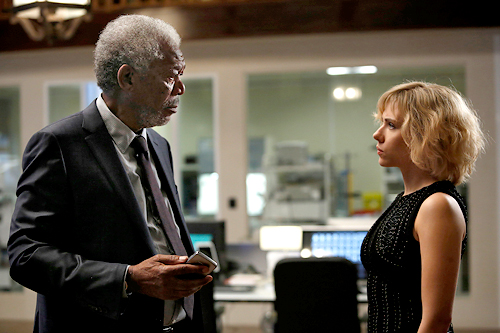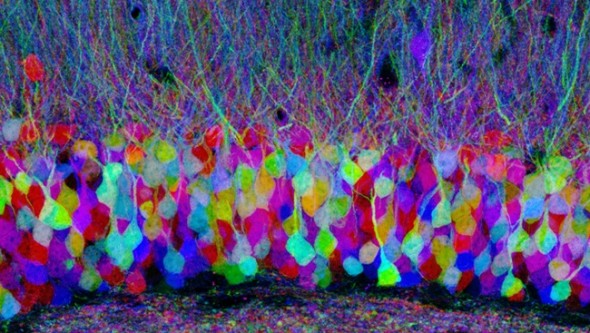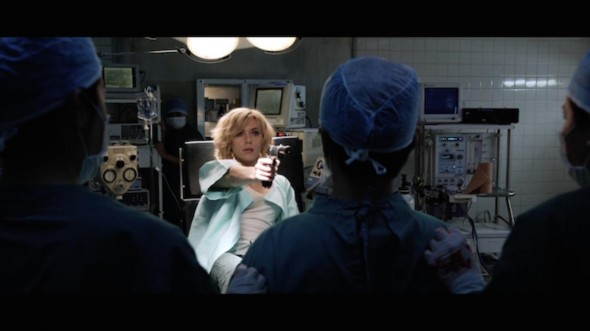[Enjoy this guest post by neuroscientist Ashley Juavinett. -Ed]

Morgan Freeman has a commanding voice, but don’t be fooled when he tells you that humans only use 10% of their cerebral capacity. It’s still no more than a myth. Thanks to Lucy and the publicity it has garnered, we’ve been able to put this myth on a pedestal, examine it, and ultimately lock it in a backroom somewhere, hopefully never to be seen again. But in spite of its bad science, Lucy actually provides some helpful on-screen metaphors of brain function that allow us to explore the reality of under-, over-, and adequately powered brains.
A myth of dubious origins
The beginning of the pervasive 10% myth is debated, and it’s not clear exactly which allusion to using just a portion of our brains really caught on and became part of the collective conscious. Still, we have a few clues. William James alludes to “making use of only a small part of our possible mental and physical resources” in The Energies of Men (1907), which was then alluded to and transformed into the 10% statistic by Lowell Thomas in his introduction to How to Win Friends and Influence People (1936).
In addition, it’s likely that early neurology observations by Wilder Penfield and others that patients could lose parts of their brain without any noticeable outcome further propagated this idea. Also, “neuroporn” – images of the brain showing blobs of activity that seem to explain our very existence – doesn’t help. Those “blobs” aren’t the only areas of the brain that are active; they are the areas that were preferentially active while the patients complete a task in the scanner.
What brains normally do with their time
First, let’s define “use.” The brain is a finely tuned machine composed of electrochemical signaling cascades that are dependent on a predictable environment of ions and neurotransmitters. The key players in these biological shenanigans are neurons and glia, working in a push-and-pull matter with local and distant neurons and glia to balance inputs and control outputs. All this is to say that “use” is a difficult verb to apply to brain function. Even reducing it to neuron-to-neuron communication is an oversimplification, but let’s roll with that as our measure of “using” brain matter.

In an interview with Vulture, director Luc Besson states, “What is true is that we’re using only 15 percent of our neurons at one time,” without citing a source for this false statistic. In order to derive it, you would need to record from each and every neuron of a brain – something we can barely do in creatures with 302 neurons, better yet 86 billion – and count how many were active at any given moment. Our closest possible answer to this question comes from observing blood flow (a proxy for neural activity) in a scanner, which has illuminated a remarkable amount of brain activity, even at rest. This type of research even has a name, resting state fMRI, and might prove to be a biomarker of certain neurological disorders.
But you’re not exactly firing every single neuron in your brain simultaneously, either. Hyperactive excitatory neurons, without a balance of inhibition, can lead to seizure, and too much sensory input without the filter of attention leads to sensory processing disorders. While each neuron is continuously playing a role in its network, it may be more or less active. Thanks to decades of system neuroscience, we have a fairly informed idea about what portion of neurons within certain parts of the brain might be used at any given moment.
Although Lucy goes astray with absurd examples of an overpowered brain manipulating space, time, and objects, the film can still provide us with some insight into memory as well as attentional processes, and what these might look like at truly full power.
Remembering without forgetting
As Lucy sits on the operating table while the packet of drugs is removed from her stomach, she phones her mother and rambles on about how she can barely concentrate. Lucy sifts through stores of memories from her adolescence and childhood, even as far back as breastfeeding. Presumably, her increased brain capacity is overdriving her hippocampus, resulting in this endless stream of distant memories. As a result, the viewer is left with the intuition that perhaps it is a good thing we don’t have continuous open access to our memories. Imagine simultaneously remembering each scraped knee, each break up, each and every time you brushed your teeth. Slightly distracting, perhaps. Fortunately, this isn’t how our hippocampus normally functions.
Each second, your hippocampus generates neurons to mark the time and location of everything that happens in your life, building complex neural networks that hold our deepest secrets. The hippocampus and its enveloping cortex are responsible for a variety of different types of memory, including spatial, episodic, and declarative. Most theories of memory posit that individual places and times are stored here in dynamic circuits of neurons (often called an engram), and that when you recall these moments, a particular network is reactivated.
Because these circuits are dynamic, the more you access them, the more they are likely to change (this is why eyewitness testimony is quite problematic). If these circuits were constantly active, you would be flooded with a jumble of places, times, and people, making current time and space quite confusing. Our darling protagonist experiences exactly this, stumbling through a phone call with her mother, barely able to construct a coherent narrative.

Seeing without attending
In a similar way, attention involves filtering out most of the visual, auditory, and sensory information in our environment, and Lucy finds herself overwhelmed by all of the stimuli. During surgery, Lucy further explains to her mother that she cannot “feel pain” – it’s all part of a jumbled mess of sensory information that Lucy’s body is receiving. Under normal circumstances, our brain, particularly our insula, filters out incoming input from our body, only becoming conscious when absolutely necessary (think: hot stove), and ignoring information that isn’t (your legs against your chair). Our brain has a remarkable ability to attend to important things, filtering out the garbage. In a way, this means it is “using” less than its full capacity – attention is defined by focusing on only a certain subset of inputs. Consequently, while Lucy handled the unfiltered memory issue well, it fumbles with the notion of attention with an overpowered brain.
Ironically, Lucy ultimately learns to pay attention to specific things, which would, by definition, require using only a portion of her sensory capacity. Lucy leaves the hospital and embarks on a journey to track down the bad guys who left that pesky bag in her stomach. In one scene, she flips through each of the phone calls around her to find her target, listening to each and every one in turn. Besides having ultrasensitive hearing (which, by the way, would require some pretty serious ear upgrades, not just cerebral capacity), Lucy would need to tune out the other phone calls, requiring an attentive brain.
Once she locates the bad guy using her keen attention abilities, Lucy swerves through traffic, way past the speed limit and often on the wrong side of the road. It’s impressive, but again, it’s entirely dependent on being able to focus on important information in the environment. This is a feat our brain accomplishes each and every moment: there are a billions of photons hitting the back of your retina, creating a biochemical path of information through your thalamus and back to your visual cortex, but ultimately only the text on this screen is being consciously processed. Awareness tests are a great demonstration of this phenomenon. Lucy needs to be able to concentrate on only the cars ahead of her – not the sky above, not the terrified passenger next to her, not the buildings on the side. Therefore she is not using each piece of information about her visual environment, and ignoring the most of the information that reaches her visual cortex.

As Lucy’s brainpower approaches 100% towards the end of the movie, she appropriately loses the ability to focus and becomes less interactive and more mechanistic. We are left with a sense that simultaneously interpreting everything in our world would be quite overwhelming, and this is the exact type of sensory experience that many individuals with sensory processing and autism spectrum disorders experience each and every moment. By the end of the movie, Lucy is basically a robot, and proper social interaction comes second to keeping up with the constant flow of stimuli. Indeed, many theories of autism suggest that sensory overload is the main factor underlying the social difficulties of these individuals, and Lucy gives us some insight into this idea.
Learning from Lucy
At moments, Besson’s quirky, comical edge is lost and Lucy hinges on being too real – especially for those who missed the announcement that the 10% notion is a falsehood. Even still, the viewer can take away some useful insights about what certain aspects of brain function, such as memory and attention, would look like at a true 100%. In a way, it is correct that we only use a portion of our memory and attention at each given moment; firing all of these neurons at once would be impractical and problematic.
It’s not unusual, or unhealthy, to believe that there is untapped human potential, as James was referring to. The remarkable capabilities of savants like Daniel Tammet persuade us to believe in some higher level of brain functioning that we’re not reaching. But although “human potential” is a purely psychological idea, we relentlessly squeeze such concepts into biological constructs. We should all strive to increase our human potential, but this idea of using only 10%, or a full 100%, of your cerebral capacity in terms of neurons? As Lucy shows us, it’s not that simple.

Ashley Juavinett is a Neurosciences PhD student at UC San Diego, a musician when the moment is right, and an aspiring communicator of good science. She is a co-founder of NeuWrite San Diego, a collaborative writing group for mind-inclined scientists and writers, and a semi-active person on Twitter. You can find her at @ashleyjthinks.

Another possible source I have read was an early study that indicated ~10% of the brain produced a visible motor response when stimulated. As a very rough estimate this would be a plausible number to come to.
“Our closest possible answer to this question comes from observing blood flow (a proxy for neural activity)”
…we assume.
Hey TheBlackCat – thanks for your comments.
Curious about this study you’re citing – but yes, only a small portion of our brains is dedicated to producing motor responses. The rest is taking care of everything else your body needs to do.
Many labs have verified that blood flow is a reliable (albeit coarse) measure of brain activity, by simultaneously measuring fMRI signal and electrophysiology. Blood flow occurs on a much bigger scale, but when we’re simply asking which regions of the brain are active, it’s pretty decent.
As I analogized elsewhere, saying the brain uses 10% of its capacity is like saying your computer uses 10% of its “capacity” because the CPU takes up only a fraction of the motherboard. The “brain” also includes support cells and the like. Now if they had said that the brain works at only 10% of its theoretical maximum efficiency, that would be somewhat more acceptable.
Richard – absolutely. Though it’s difficult to define “efficiency” in terms of neural function really means; there are some steep costs to trying to be too efficient (you loose visual and motor precision, etc.) Most of our brain processing is arranged in parallel so that very quick, efficient streams run alongside slower, but more accurate streams, allowing us both react quickly and ultimately not make costly mistakes.
*in terms of what neural function